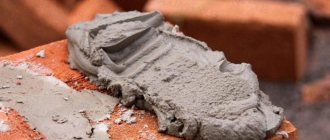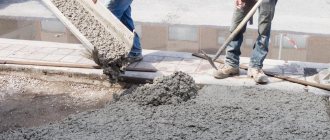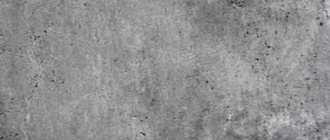SOLUTION BRAND M200
Order
| Brand | Frost resistance F | Styling brand | Price per 1 m3 (with VAT 20%) | |
| Masonry | Mounting | |||
| M200 | 75 | PC3 | 3070 rub. | |
offers construction organizations and individuals in St. Petersburg and the region to purchase ready-made cement mortar M200. The production of the material is carried out directly at the enterprise in strict accordance with the standard technological process. Then the M200 brand solution is loaded into vehicles equipped with concrete mixers and sent to the site. This type of interaction is primarily beneficial for builders, as it saves working time and the allocated budget.
Concrete M200: main characteristics and composition
Heavy concrete is a sought-after building material, without which large-scale or small-scale construction is impossible. For the construction of buildings and structures, as well as for the production of reinforced concrete products, depending on the purpose and planned load, various grades of heavy concrete are used: M100, M150, M200, M250, M300 and others.
- Technical characteristics of concrete M200
- M200 concrete proportions
- Consumption of components for preparing 1 m3 of concrete M200
Heavy concrete M200 is characterized as a universal material, optimal for the following most common construction works:
- Heavy concrete M200 is widely used for the construction of strip, monolithic and block foundations for high-rise and low-rise buildings.
- Concrete grade M200 is the main grade in the production of reinforced concrete products for various purposes: floor slabs, window and other lintels, flights of stairs, rings of water supply and sewer wells, paving slabs and curbs, road surface slabs, load-bearing columns, etc.
- Floor screed, blind area, monolithic walls of buildings, sidewalks, garden paths and decorative elements: sculptures, flowerpots, flowerpots, bench bases, etc.
Our advantages
Stable
quality
We test concrete in our own laboratory
Low
prices
Wholesale prices for building materials
Rent
Special equipment
Concrete pumps and concrete mixer trucks in stock
Operational
delivery
Timely shipment of concrete, meeting deadlines
Accredited laboratory
We deliver concrete throughout St. Petersburg and Leningrad Region
Realized objects
Pouring the foundation for a cottage in the Vsevolozhsk region
Construction of an office building in Yanino
Construction of the SKA arena near the Prospekt Bolshevikov metro station
Construction of a residential complex on Kondratievsky Avenue
Construction of cottages in the village of Manushkino
Construction of a kindergarten in the Krasnogvardeisky district
Historical information
The Romans were not the first to experiment with lime, mixing some components into it to give the material the appropriate properties. Later, in the Middle Ages, it was discovered that the products of limestone firing were not inferior in water resistance to the volcanic pozzolanic mixtures of the resourceful Romans.
The founder of the modern cement industry can rightfully be called the chemist A.R. Shulyachenko, and the Antonov lime kiln is widely used in the production of clinker. Well-known chemists I. F. Ponomarev, Yu. M. Butt, S. M. Royak, etc. devoted a lot of time to the issues of technology for the production of cement and the hardening of hydraulic binder mixtures in the Soviet Union.
Types of cement-sand mixtures by functional purpose
For the main purpose, solutions based on CPS in accordance with GOST for the following types:
- Masonry
. To prepare masonry mortars intended for the construction of brick walls, sand is used, the grain size of which does not exceed 2.5 mm. For rubble stone masonry, plastic material can be used, in which the sand grain size reaches 5 mm. - Mounting ones
, including those used when installing floor screeds. To fill the floor, CPR no lower than grade M150 is used. Such plastic products, after hardening, form a highly waterproof layer. Cement-sand mortars (CSM) can be used for screeds with a thickness of no more than 30 mm. If their thickness exceeds this value, then a concrete mixture will be required. - Facing
. These can be finely dispersed compositions, which make it possible to obtain a very smooth surface, or materials with decorative components - marble or granite chips, pieces of mica or glass. - Plastering
. In the production of plaster CPR, sand with a grain size of up to 2.5 mm is used, for the covering layer - 1.25 mm. The required brand of solution is selected depending on its functional purpose. TsPR M50 can only be used for final surface finishing, M100 - for interior finishing work in rooms with normal humidity levels. To finish walls and ceilings in wet rooms, as well as plastering facades, you will need a CPR grade of at least M150.
Answers to frequently asked questions
Is it acceptable to use grade 200 cement mixture in standard construction?
The mixture is universal, suitable for a wide variety of construction work.
Is it permissible to work with M200 mixture in the Far North?
Cement composition "200" is suitable for work at extremely low temperatures in extreme climatic conditions.
What differences on the walls are acceptable when working with M 200?
Without the use of a reinforcing structure, differences of up to three centimeters are permissible. The substance is quite plastic, it does not crack after drying.
Is it possible to work with M 200 in basements where there is high humidity?
M 200 is an ideal material for working in basements and basements
How much does a cube of M 200 solution weigh?
About 2.4 tons
Purpose
Sand-cement mixture of general purpose belongs to heavy type concrete. Most often it is used in the process of pouring frame structures, garden paths and monolithic foundations. The brand is focused on performing small construction or household work.
Portland cement cement is not used in the construction of multi-story buildings and other complex structures. In areas where temperature changes are common, cement 200 is rarely used due to its low frost resistance.
Technical conditions of use
The technical conditions of use mean the correct preparation and application of the solution:
- The surface must be cleaned and degreased (if necessary) before applying the solution. Maintaining the temperature (above +3... +5°C) is a prerequisite to maintain the integrity of the coating.
- Further work (installation of formwork) is carried out only after the solution has completely hardened. The best option is to give the mixture 26-28 hours to set.
- When mixing, the solution must be kept for 3-4 minutes, then mixed again.
- To make the mixture more homogeneous, it is better to mix the solution in special equipment - a concrete mixer. You can beat the mass with a construction mixer or a drill (with an attachment).
- The dry mixture must be diluted correctly. The powder is added to the water in parts, rather than filling the cement with liquid.
Compliance with the proportions will allow you to calculate in advance the approximate consumption of proportions and draw up an estimate.
Density indicator of cement powder
The specific gravity indicator in the case of bulk materials is found by dividing their mass by the occupied volume and has a direct relationship with the degree of compaction and the proportion of entrained air. Portland cement and similar types of binders obtained by grinding sintered clinker are no exception; this value varies in different states. The exact value of bulk density depends on many factors: from the parameters of the cement paste and grinding characteristics to storage conditions and the current quality of the grains. Taking it into account when selecting and checking the proportions of other components of building mixtures eliminates errors during mixing and improves their properties.
The concept of density and the influence of the indicator
In dry form, this binder is a suspension of dust-like grains and air, the involved proportion of the latter directly depends on the degree of electrical charge between individual particles. This type of bulk building materials cannot be classified as dense; after mixing, the powder is almost completely distributed in the water and between the filler particles. The maximum rarefaction is observed in freshly ground and blown compositions, the minimum - in those compressed during transportation, vibration or long-term storage. The specific gravity has an inverse relationship: in a loosened state - no more than 1300 kg/m3, in a compacted state - reaches 1600. The worst indicators are observed in damp brands that have begun to clump.
The difference between the true density and bulk density is quite large (for PC 3100 kg/m2 compared to 1200). The value of the mass of the binder without voids indirectly indicates the strength and other related characteristics that affect the ductility, weight and workability of future mixtures. The true density of pozzolanic, slag- and sulfate-containing grades is inferior to Portland cement (2700-2900 kg/m3 compared to the minimum 3100). The maximum is observed in varieties with barium oxides.
As a result, the density of cement in dry form is influenced by:
- Composition and final strength grade of the binder.
- The method of clinker formation and the fineness of its grinding.
- Activity - the minimum bulk density is observed immediately after grinding in mills.
- Time of contact with open air and storage method. The absorption of moisture from the environment by Portland cement increases the mass of 1 cubic meter to 1600-1700 in comparison with the standard 1300. The necessary parameters are maintained when they are placed in silos with aeration or similar specialized tanks; worse results are achieved with long-term storage of cement in bags or big bags packed Each other.
- The presence or absence of additional additives. Pure PC is laid more densely than mixtures with slag or mineral impurities added. But the final porosity of artificial stone when used will be less.
| Variety | Standard range or average density, kg/m3 | |
| True | Bulk (specific gravity in a loose state) | |
| Alumina grades | 3050-3100 | 900-1150 |
| Non-additional PC, M300-M500 | 3100-3500 | 1100-1600 |
| ShPC | 2950-3050 | 1150-1250 |
| Sulfate-slag mixtures | 2850-2950 | 1050-1200 |
| Pozzolanic Portland cement (PPC) | 2750-2950 | 850-1150 |
| Sulfate-resistant PPC | 2700-2850 | 850-1100 |
Technical characteristics of concrete M200
There are several types of such a mixture, which will determine the composition of 1 m3 of M200 material:
- Heavy - the formulation includes coarse aggregate such as crushed stone, gravel or granite.
- Fine-grained - a lightweight mixture, without coarse aggregate.
- Lightweight - it uses large porous aggregate as a filler: expanded clay, agloporite, slag crushed stone.
Let's consider the standardized values of technical characteristics according to GOST 26633-2012:
| Name | Values |
| Strength class | B15 |
| Mark her | M200 |
| Average compressive strength | 196 kgf/cm 2 |
| Guaranteed rate | 15 mPa |
| Average density | 2300−2400 kg/cm 3 |
| Mobility | P2 – P4 |
| Waterproof grade | W2–W6 |
| Frost resistance grade | F50 – F150 |
| Weight 1m 3 | 2300 – 2400 kg |
Brand and strength class are GOST indicators by which it is customary to designate such materials. According to modern standards, a class system has been introduced, but many still sell and buy concrete with the old markings.
- Density directly depends on the proportion. Compliance between the latter and the strength of the test sample is an indicator of high quality and durability. A denser material can withstand greater strength, but due to the greater mass there is an increased load on the foundation, soil or building. Therefore, density is no less important an indicator than strength.
- Mobility is a characteristic necessary directly during work. The more flexible the mixture, the easier it is to mold. But too much cone draft may indicate poor quality.
What is the density of concrete and how is it measured?
The density of concrete is its main parameter, which largely determines the important characteristics of finished monolithic products. First of all, their strength and ability to withstand external factors (excess humidity, frost). That is why the weight of the mortar and finished concrete, as well as the grade, must be selected in advance, focusing on operating conditions.
As with other physical bodies, the density of a cement mixture or stone indicates how much a unit volume weighs. In documents it is given in kg/m3 or t/m3, less often in g/cm3, but the difference here is only in the order of the numbers, the numerical values remain essentially the same, so it will not be difficult to navigate. Officially, in the marking, the volumetric weight is indicated by the letter D and is indicated in kg/m3. We also suggest that you familiarize yourself with the density and weight of reinforced concrete.
Density is tied to the compression resistance indicator, which is directly dependent on it. In the case of lightweight concrete, it can simultaneously characterize the porosity, as well as the heat and sound insulation properties of the stone. However, the opposite principle is already in effect here, that is, as the volumetric weight of the monolith increases, its strength increases, but at the same time the energy efficiency of the structures being built decreases. Understanding these connections allows you to make the right choice of building materials for any job.
How to influence volumetric weight?
The density of a concrete monolith is largely determined by the characteristics of the components of the mixture. It is their selection that attention should be paid to in order to obtain the desired weight of concrete solution at the output. Moreover, the actual composition and ratios in the recipe are far from the only decisive factor.
More than half the mass of concrete is made up of coarse aggregate, so it is initially necessary to determine its own weight and even bulk density. The latter will show how many air pockets remain inside for sand and cement, but the mass of stones will make a much more serious difference. For example, if the composition of B25 includes granite or dolomite crushed stone with a strength of M600, its own density will be so high that the concrete will be no lower than D2200-2400. And pumice, expanded clay and tuff will give only a lightweight type of monolith no heavier than 1.6-1.8 t/m3.
The type of binder component influences the change in the density of cement stone slightly less. For example, to create heavy concrete, the following types are used:
- Portland cement is the most popular option, characterized by the finest grinding.
- Pozzolanic ash is a special type of cement that reduces the water requirement of the mixture and, accordingly, reduces the consequences of its evaporation.
- Aluminous - compared to PC, it gives 1.5 times less porosity of the monolith.
In order to ultimately obtain concrete with the required values of density and strength, they always take cement of a higher grade - as a rule, by 2-3 grades (this difference in the solution will be “eaten up” by cheaper components such as sand and water).
The amount of liquid in the finished mixture determines the future porosity of the monolith, since air bubbles in the cement matrix are formed after the moisture evaporates. That is why experienced builders do not recommend adding more water than is necessary for normal hydration, so as not to reduce the strength characteristics and density of concrete. Of course, this alone will not rid the artificial stone of air pores, but it will noticeably reduce the ratio of their number to the entire volume.
The density of the cement monolith can be changed with the help of other components of the solution, but not so noticeably. For example, weight gain is caused by the use of fine aggregates. And do not forget about special plasticizers that improve the fluidity of the mixture, while simultaneously reducing the amount of liquid in it (we have already discussed how this will affect the number of pores).
Placement technology and subsequent processing of the casting can also increase the volumetric weight of concrete. The desired effect is achieved by:
- Bayoneting.
- Vibration compaction.
- Warming up the monolith.
For some solutions, vacuuming can also be used - removing air and excess water from the mixture before it hardens. True, their preparation requires the use of silicate cement, and the technology itself is quite complex. But as a result, it is possible to increase the density of the monolith by about 20%.
There is no strict division of concrete according to volumetric weight and strength indicators, since the latter are also influenced by the own characteristics of the aggregates used (compression resistance, fractional composition). But in general, you can focus on generally accepted values.
D2500-6000 kg/m3 – grades of especially heavy concrete for the construction of special structures. Here, the high weight of the finished monolith is determined precisely by the high-mass fillers used:
- Barite.
- Limonite.
- Magnetite.
- Domain scrap.
- Metal filings.
D2200-2500 kg/m3 - this is the density of heavy concrete, more often chosen for the construction of critical structures. When preparing it, the most common solution is used with the addition of crushed stone or gravel and sand. Brand strength corresponds to M300-M800, guaranteed strength lies in the range from B20 to B60.
D1600-2200 is a lightweight monolith (usually M200-M600 brands), which is widely used in low-rise construction and finishing work. With this density, despite the name of the group, the strength of the finished stone corresponds to fairly high classes B20-B40.
Application area
From the listed properties, the scope of application of concrete grade B15 M200 follows. The main thing you should pay attention to is water resistance. This may be important when pouring a foundation in conditions of high groundwater levels. In this case, it is better to choose a composition that is water-resistant. Otherwise, the scope of use of M200 concrete is as follows:
- In the production of reinforced concrete foundation blocks.
- Flights of stairs, other elements of stairs.
- Floor slabs.
- Paving slabs.
- Pouring concrete paths.
Most often, concrete of this brand is used for strip foundations.
- Strip foundations for one-story houses.
- Foundation for a fence.
- Screed (with a thickness of 5 cm with fine crushed stone).
Depending on the thickness of the required layer, the size of the aggregate - crushed stone - is selected. The maximum particle size should be no more than half the layer. Therefore, a distinction is made between concrete grade M200, coarse-grained and fine-grained. In the first version, gravel is used in a large size, in the second - small.
Cement sand mortar M200. Specifications
Mortar M200 is one of the most popular materials in modern construction. It is characterized primarily by strength and reliability. The M200 solution shows the best technical characteristics in factory preparation conditions, since production is carried out by automated equipment. High quality cannot be achieved without high-quality raw materials. Cement sand mortar M200 is prepared from cement and sand. At the request of the customer, special components are added to the material to improve the quality and give the material special properties.
| Masonry mortar class M200 | Material Density | Frost resistance | Water resistance | Mobility | Weight 1m3 |
| B15 | 2385 kg/m3 | F 200 | W6 | P3 | About 2.4 tons |
In the production of ready-made masonry cement mortar grade 200, only washed sand and M400 or M500 cement are used. The proportions of the components depend on the brand of cement.
Production
A fine powdery dry mixture is formed during the grinding of gypsum and silicate clinker, which allows you to regulate the curing time of the solution during the construction period. Firing of finished raw materials occurs at a temperature of +1470… +1490°C.
To reduce the cost of cement and improve its technical characteristics, various additives are added to the powder (no more than 15%):
- flasks;
- pyrite cinders;
- sand;
- bauxite.
The composition of M200 cement, regardless of the production stage, has a number of common characteristics with other brands. Predetermination of further marking occurs at the final stage, when binders are added to the raw material.
On the territory of the Russian Federation there are more than 30 factories specializing in the production of cement of this brand. There are 4 large enterprises located in Moscow and the Moscow region (Kolomna, Podolsk, Voskresensk, Khorlovo).
The factories are equipped with the necessary equipment, which allows them to produce high-quality products. Production capacity is up to 3,100,000 tons of material per year.
Proportions
The ratio of components for M200 concrete is taken in parts:
The amount of cement and sand-gravel mixture is taken in a ratio of 1:8.
You should know how much cement should be contained in a cube of M200 concrete; its mass is approximately 300 kg.
To obtain a product of the required quality, it is necessary to select the C:P:B ratio. Material consumption to obtain 1 m³ of concrete mixture:
| Component | Weight, kg | Contents, part |
| Cement M400 | 280 | 1 |
| Sand | 784 | 2,8 |
| Crushed stone | 1344 | 4,8 |
| Water | 20 % | 20 % |
| Plasticizer | 4,8 |
The composition of concrete in proportion is convenient to use when making a mixture on a construction site or for home use. For industrial production, the composition of the solution is standardized by GOST, the amount of each component is indicated in kilograms.
Here is a simple method for making a cubic meter of M200 concrete using this recipe:
- 6 bags (50 kg each) of M400 cement;
- 48 buckets (10 l) of sand;
- 74 buckets (10 l) crushed stone;
- 20 buckets (10 l) of water.
If M500 cement is used to prepare M200, then 3.5 sand and 5.6 crushed stone are required for one part of cement. In any case, water should be no more than 20% of the volume.
Material consumption
Concrete mortar based on M200 can be made independently. Proportions per cubic meter of area:
- water (saline solution) - 175-185 l;
- sand (river, washed) - 580-600 kg;
- gravel - 0.8-0.9 cubic meters (about 1250 kg);
- cement - 320-330 kg.
The total volume of the finished mixture is 1.3-1.4 cubic meters. Particles of sand or gravel are forced between stones or concrete slabs, forming a bubble-free substance.
To prepare a solution that will be used for construction and household purposes (finishing walls, pouring paths), it is better to use small iron buckets to measure materials.
Proportions:
- Bucket capacity 10 l. Cement - 13 kg, sand - 16 kg, gravel - 16-17 kg.
- Bucket 12 l. Cement - 15.5 kg, sand - 18.5 kg, gravel - 20.5 kg.
The mobility of the mixture after the cement has dissolved directly depends on the amount of liquid. Water is added in small portions. A viscous solution is used in the construction of a monolithic foundation.











